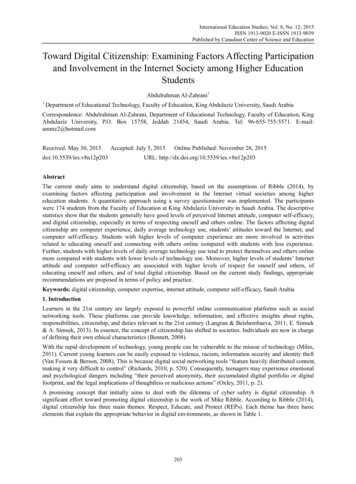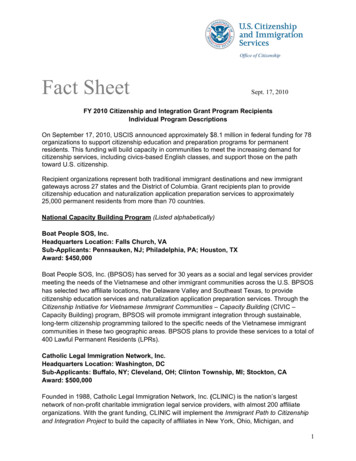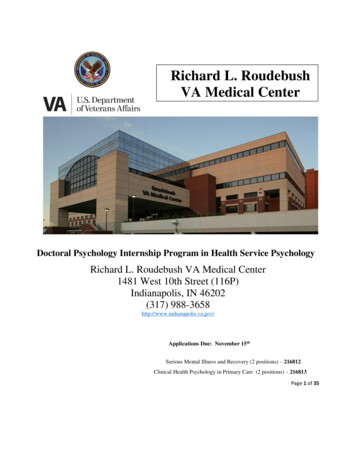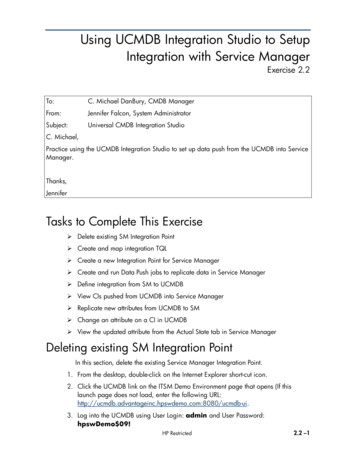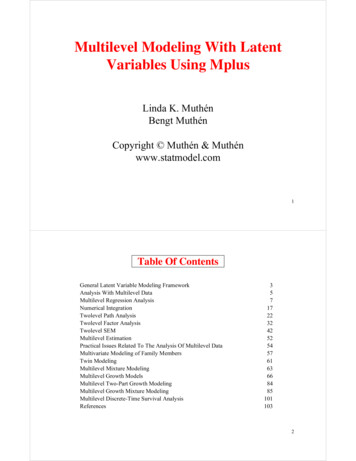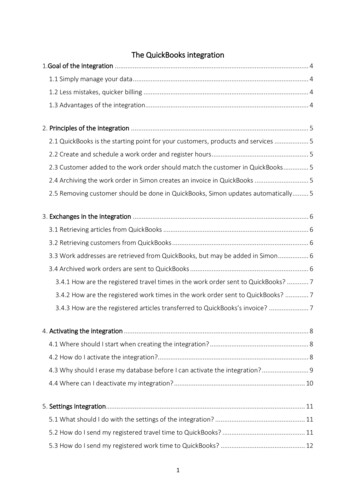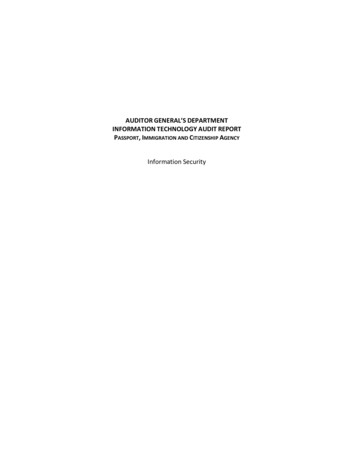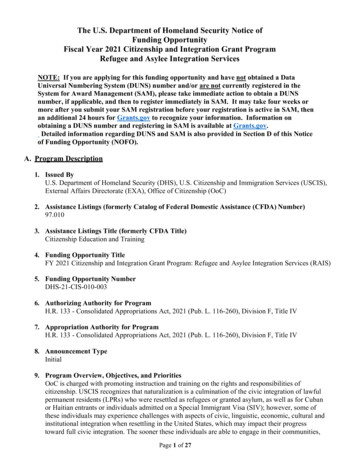
Transcription
The U.S. Department of Homeland Security Notice ofFunding OpportunityFiscal Year 2021 Citizenship and Integration Grant ProgramRefugee and Asylee Integration ServicesNOTE: If you are applying for this funding opportunity and have not obtained a DataUniversal Numbering System (DUNS) number and/or are not currently registered in theSystem for Award Management (SAM), please take immediate action to obtain a DUNSnumber, if applicable, and then to register immediately in SAM. It may take four weeks ormore after you submit your SAM registration before your registration is active in SAM, thenan additional 24 hours for Grants.gov to recognize your information. Information onobtaining a DUNS number and registering in SAM is available at Grants.gov.Detailed information regarding DUNS and SAM is also provided in Section D of this Noticeof Funding Opportunity (NOFO).A. Program Description1. Issued ByU.S. Department of Homeland Security (DHS), U.S. Citizenship and Immigration Services (USCIS),External Affairs Directorate (EXA), Office of Citizenship (OoC)2. Assistance Listings (formerly Catalog of Federal Domestic Assistance (CFDA) Number)97.0103. Assistance Listings Title (formerly CFDA Title)Citizenship Education and Training4. Funding Opportunity TitleFY 2021 Citizenship and Integration Grant Program: Refugee and Asylee Integration Services (RAIS)5. Funding Opportunity NumberDHS-21-CIS-010-0036. Authorizing Authority for ProgramH.R. 133 - Consolidated Appropriations Act, 2021 (Pub. L. 116-260), Division F, Title IV7. Appropriation Authority for ProgramH.R. 133 - Consolidated Appropriations Act, 2021 (Pub. L. 116-260), Division F, Title IV8. Announcement TypeInitial9. Program Overview, Objectives, and PrioritiesOoC is charged with promoting instruction and training on the rights and responsibilities ofcitizenship. USCIS recognizes that naturalization is a culmination of the civic integration of lawfulpermanent residents (LPRs) who were resettled as refugees or granted asylum, as well as for Cubanor Haitian entrants or individuals admitted on a Special Immigrant Visa (SIV); however, some ofthese individuals may experience challenges with aspects of civic, linguistic, economic, cultural andinstitutional integration when resettling in the United States, which may impact their progresstoward full civic integration. The sooner these individuals are able to engage in their communities,Page 1 of 27
the more likely they are to find satisfaction and success in their personal and professional lives;make positive contributions to their communities and the Nation, and become naturalized citizens. Itis critical to provide refugees and asylees, Cuban and Haitian entrants, and SIV recipients withopportunities to gain the knowledge and skills necessary to fully integrate into American society.The goal of the RAIS funding opportunity is to provide extended integration services, whichbuild on, but are not intended to replicate, those resettlement services funded by the U.S.Department of State’s Bureau of Population, Refugees, and Migration and the U.S. Departmentof Health and Human Services’ Office of Refugee Resettlement, which prioritize early economicself-sufficiency. The primary focus of the RAIS is to provide individualized programming toLPRs who entered the United States under the U.S. Refugee Admissions Program (USRAP),were granted asylum, as well as Cuban or Haitian entrants and individuals on an SIV, to attainthe skills and knowledge required for successful citizenship and to foster a sense of belongingand attachment to the United States. Although the title of the program refers only to refugees andasylees, LPRs who entered the United States as Cuban or Haitian entrants or wereadmitted on an SIV are also eligible for services under this program. This grant strives topromote long-term civic integration of those LPRs who have identified naturalization as a goalyet may need additional information and instruction to attain it.Applicants are required to demonstrate in-depth experience with, and extensive knowledge ofthe particular community they propose to serve and describe how the proposed program designwill address the identified integration needs of this population. Applicants are required topropose a program that provides a suite of integration services to LPRs who entered the UnitedStates as refugees, asylees, Cuban or Haitian entrants, or those on a Special Immigrant Visa thatwill promote long-term civic integration. Through individual needs assessments, completion ofintegration plans for each enrolled LPR, provision of information and guidance on availableintegration services, provision of civics-based literacy, civics-based English language, andcitizenship instruction to prepare for naturalization, those served under the program will gain thetools required to become successful citizens.Applications must propose a detailed plan on how they will assess each LPR and develop andmonitor the implementation of an individual integration plan for those served under the program.Submission of the proposed integration plan template is required as an attachment to thisapplication. As part of each individual’s integration plan, applicants must make referrals to thefollowing integration services based on the LPR’s specific identified needs: communityorientation; referrals and interactions with local government and public institutions; referrals toemployment training; and referrals to appropriate sources of information for updating orrenewing previously held foreign professional credentials when applicable. In addition to theproposed integration services, the cornerstone of the program design must include civics-basedliteracy, civics-based English as a second language (ESL) instruction, citizenship instruction,and free naturalization legal services within the authorized practice of immigration law.Naturalization legal services cannot be provided to individuals who have not undergone theinitial integration assessment and have not had an integration plan completed on their behalf.The primary applicant or a sub-awardee must directly provide either citizenship instruction ornaturalization legal services. Civics-based literacy and civics-based ESL instruction may beprovided by the applicant or sub-awardee. Other required integration services may be providedthrough systemic and documented referral to other local community service providers withwhom the primary applicant has a pre-existing and well-established relationship.Page 2 of 27
OoC may suggest changes to the integration proposal after reviewing the applicant’s programdesign either during the negotiation period or the first quarter of the funding period. Grantrecipients will be required to develop and monitor the implementation of an individualintegration plan for a minimum of 200 LPRs who have identified naturalization as a goal.Furthermore, the goals of the Citizenship and Integration Grant Program support the objectives ofExecutive Order 14012, Restoring Faith in Our Legal Immigration Systems and StrengtheningIntegration and Inclusion Efforts for New Americans, by promoting integration, inclusion, andcitizenship.The Citizenship and Integration Grant Program also addresses the DHS mission to enforce andadminister our immigration laws as stated in the 2014 Quadrennial Homeland Security Review asthe program provides LPRs instruction on the rights and responsibilities of U.S. citizenship andinformation and support on how to apply for naturalization within the authorized practice ofimmigration law.In fiscal year (FY) 2021, up to 1.8 million in federal funding is available for eligibleorganizations to provide integration services to LPRs who entered the United States as refugees,asylees, Cuban or Haitian entrants, or on a Special Immigrant Visa. (Please note that throughout therest of this document, lawful permanent residents who were admitted or entered the UnitedStates as refugees, asylees, Cuban or Haitian entrants, or on a SIV will be referred to as“program beneficiaries” or “program beneficiary” in the singular.) USCIS seeks to awardapproximately six grants of up to 300,000 each.Proposed services must include the four mandatory elements listed below:1. Development of an individual integration plan for each program beneficiary who willreceive services.The intent of this requirement is to develop an integration road map for program beneficiarieswho have identified naturalization as a goal, including those who are not yet ready to apply fornaturalization and may require interim services to attain the skills and knowledge required forsuccessful citizenship. Each enrolled LPR should be assessed for English language level andnaturalization eligibility and provided with information on the naturalization process andguidance on what steps are needed to prepare for naturalization. This naturalization-focusedassessment should be considered the foundation of the individual integration plan that must becompleted for every enrolled program beneficiary, with services and referrals tailored to thespecific skills, needs, and literacy level of the individual. Each program beneficiary must beoffered enrollment in civics-based literacy, civics- based ESL, or citizenship instruction classes(see 4 below) as appropriate.2. Provision of or referral to integration services that address the specific needsidentified in the program beneficiary’s individual integration plan.Grantees must offer access to a range of services designed to foster long-term integration thatare tailored to the specific needs of the target population. Below are some of the types ofintegration services that could be funded under this grant. Grant recipients may propose otherservices based on the identified needs of the communities they propose to serve.a. Community orientation and settlement information.Building on the information that refugees receive during their initial Receptionand Placement Orientation, community orientation and settlement activitiesinclude those that allow program beneficiaries to expand, reinforce and practicePage 3 of 27
existing knowledge to foster their community participation and understandingof how to navigate local infrastructure and services. Examples of activitiesinclude but are not limited to: Creating a local community resource guide;Hosting local leaders or representatives of community services orcivic organizations as guest speakers; andCommunity based events and tours.b. Referrals to and interactions with local government and public institutions.There are usually many community-based integration support services to assist refugeesand asylees. Programs should be aware of these existing services and develop plans tocollaborate with the local government and public institutions that would most benefittheir program beneficiaries. Programs can develop lesson plans in conjunction withentities to teach program beneficiaries about their role in the community and the servicesthey offer, invite guest speakers to speak to program participants, and arrange forprogram beneficiaries to have meaningful interaction with community partners.Such institutions include, but are not limited to: (a) public libraries, (b) the Departmentof Motor Vehicles, (c) community centers, (d) law enforcement agencies, (e) clinics, (f)employment services, (g) public schools, (h) emergency management agencies, (i)historical museums, and (j) community colleges, etc.c. Referrals to employment training.Referrals to employment training may be to programs or classes that help programbeneficiaries acquire workplace-specific knowledge or skills in order to improveperformance, improve chances of advancement, or prepare program beneficiaries for futurecareer goals as identified in their individual integration plan. Grant funds may not be used topay the costs for individual employment training.d. Referrals to appropriate sources of information for updating or renewing previously held foreignprofessional credentials when applicable.Organizations may make referrals for those program beneficiaries who have identified thegoal of employment in their pre-immigration career fields. Assistance may be in the form ofwritten information or guidance, facilitating a mentoring relationship between the programbeneficiary and a volunteer with experience in the same field, or referrals to agencies orprofessional organizations that assist individuals to recertify or obtain the requiredprofessional credentials to re-enter their chosen field. Grant funds are not intended to payfor the costs of individual re-certification or re-credentialing services for programbeneficiaries.3. Civics-based literacy instruction, civics-based ESL instruction, and citizenshipinstruction to provide enrolled LPRs with the skills and knowledge needed to preparefor citizenship.Based on the assessment conducted to develop the program beneficiary’s individual integrationplan and student progress during the grant period, a minimum of 150 program beneficiariesshould be enrolled in an appropriate instruction level. USCIS recognizes that not all individualswill be ready for placement into a high beginning citizenship class (which is the target level forUSCIS-funded citizenship instruction) at the time they seek services to begin preparing forPage 4 of 27
naturalization. Students may start in a lower level class and progress to citizenship instruction;however, a minimum of 150 first-time student enrollments is required.a. Civics-Based Literacy and Civics-Based ESL InstructionStudents whose English level is not at the appropriate level for citizenship instruction classesshould be served through civics-based literacy and/or civics-based ESL instruction. The Officeof Citizenship defines civics-based literacy and civics-based ESL instruction as ESL classes orcomponents of citizenship classes that provide students with the English language grammar andvocabulary needed to advance through the stages of integration with the ultimate goal ofnaturalization. These categories of instruction are appropriate for individuals who do not havesufficient English language attainment to be placed in a citizenship class that focuses onpreparation for the naturalization interview and test. Civics-based literacy includes using civicsand integration concepts and themes to teach low-level students basic English grammar andvocabulary preparing them for civics-based ESL (this is targeted at program beneficiariesassessed at National Reporting System for Adult Education (NRS) level 1 – beginning ESLliteracy). Civics-based ESL focuses more heavily on teaching the English structures needed tounderstand the concepts found within the naturalization test as well as those to assist students tobecome more integrated community members (this is targeted at program beneficiariesassessed at NRS level 2 – low beginning ESL).b. Citizenship InstructionStudents assessed at the NRS high beginning level or higher should be provided withcitizenship instruction as defined below. The program design must include:1) Instruction primarily delivered in English in U.S. history and government and thepromotion of civic integration;2) Activities that promote civic and linguistic integration;3) ESL instruction in reading, writing, and speaking to support naturalization preparation;4) Instruction primarily delivered in English on the naturalization process and eligibilityinterview;5) The use of a nationally normed standardized test of English proficiency to place andassess progress of all students enrolled under this program. At least 80% of post-testedstudents must demonstrate educational gains as evidenced by increased standardizedtest scores;6) The use of a current adult citizenship textbook that aligns with the skill level of thestudents in the class (published textbooks only, compilations of worksheets orhandouts will not be accepted); all students must be issued a textbook for their ownpersonal use;7) A curriculum that includes all of the components contained in the USCIS SampleCurriculum found on the Citizenship Resource Center lopment including: Instruction in U.S. history and government for naturalization test preparation andthe promotion of civic integration; Activities that promote civic and linguistic integration; ESL instruction in reading, writing, and speaking for the naturalization test,naturalization process, and to conduct required integration activities; and Instruction on the eligibility interview for Form N-400, Application forNaturalization.8) The provision of at least 40 hours of citizenship instruction over a 10-12 week classcycle with managed enrollment to at least 150 students at the NRS high beginning tohigh intermediate levels (NRS Levels 3-5); andPage 5 of 27
9) The use of citizenship teachers who have degrees in education (K-12 Social Studies,History, TESOL, or Adult Education) and/or who have at least one year of experienceteaching adult immigrants. Although not a requirement, programs whose teachers havethe following education, certification, and/or experience are generally more likely to bescored higher than programs that do not: Hold a degree in TESOL; and/or Hold TESOL certification from a state licensing agency; and/or Have a minimum of 2 years of experience in TESOL instruction in a classroomsetting or since March 2020 in a virtual setting for an adult education program thatutilizes a textbook and a structured curriculum.Citizenship instruction classes must integrate instruction in U.S. history and government; civicsbased ESL instruction in reading, writing, and speaking; and instruction on the naturalization processand eligibility interview. For more detailed information on the content and competencies thatapplicants are required to address in grant-funded classes, please review the Guide to the AdultCitizenship Education Content Standards and Foundation Skills found atwww.uscis.gov/sites/default/files/USCIS/Office of Citizenship/Citizenship Resource CenterSite/Publications/M-1121.pdf, the USCIS Guide to Creating an Adult Citizenship EducationCurriculum found at M-1189.pdf and the USCISSample Curriculum found at M-1166.pdf.Citizenship instruction programs must also incorporate a minimum of two civic integration learningactivities into class curricula, described in detail in the proposal narrative. The intent of thisrequirement is to encourage students to extend knowledge acquisition beyond traditional classroominstruction through opportunities to experience and navigate American civic life firsthand throughin-depth learning activities. Applicants are encouraged to draw upon their local resources, venues,and landmarks when conceptualizing and designing these civic integration learning activities.Suggested categories for the required integration activities include but are not limited to: Community acculturation – Programs that help refugees and others acculturate andbecome less dependent on federal and state subsidies and services. Site-based civic integration activities – Local trips outside the classroom to sites andlandmarks of historical and/or cultural significance, libraries, museums, other local publicentities, and organizations that promote public safety, etc.; Classroom-based civic integration activities – Activities that may involve guest speakerssuch as local civic leaders and public servants to provide the opportunity for studentinteraction and exchange, or the use of multimedia and/or materials-based methods thatpromote an enhanced understanding of key moments in U.S. history and/or the form andfunction of local, state and federal government; Civic participation – Activities that encourage students to take participatory learningbeyond the classroom by attending a public meeting, volunteering, or participating in localcivic institutions; and Other integration activities – Activities that promote in-depth understanding of thestudent’s role as a future citizen of the United States, including the rights andresponsibilities of citizenship; our shared American history; government functions,structure and laws; geography; and traditions, symbols and holidays. These can be externalor in-class.4. Provision of free naturalization application services, within the scope of the authorizedpractice of immigration law.Grant recipients must provide services at no cost to the applicant to support the naturalizationapplication submission and interview process. Naturalization application services can only bePage 6 of 27
provided to program beneficiaries who have had a full assessment of their integration needs andhave a completed integration plan. Proposed Services must include: The provision of naturalization eligibility screening for a minimum of 175 program beneficiaries; The preparation and submission of Form N-400 with Form G-28, Notice of Entry of Appearanceas Attorney or Accredited Representative, over the 2-year period of performance for a minimum of150 program beneficiaries who entered the United States under USRAP or were granted asylum(USCIS recognizes that not all program beneficiaries who received other integration servicesunder this grant will be ready to apply for naturalization during the period of performance); The provision of ongoing immigration case management; The use of a U.S. Department of Justice (DOJ) Office of Legal Access Programs (OLAP)Accredited Representative (partial accreditation is acceptable) or an attorney who is an employeeof the applicant organization or the sub-awardee organization. (Pro bono or volunteer attorneysmay be used to supplement the program but may not serve as the applicant’s sole provider ofimmigration legal services, nor serve as a supervisor to staff members who are not accreditedrepresentatives and provide such services.) Attorneys and DOJ-accredited representatives mustsign Form N-400 as the preparer and submit Form G- 28 with each Form N-400 filed under thisgrant, preferably submitted through the USCIS online account at my.uscis.gov. 1 When filing theN-400 application online, users can receive automatic case status updates, find information onwhen an interview may be scheduled, view notices, submit and respond to a request for evidence,and engage in secure communication with USCIS. Grantees are strongly encouraged to file formselectronically whenever possible. In the case that online filing is not a viable option, grantees arerequired to mail the naturalization application package to USCIS on behalf of the client.Applications may not be given to the client to mail. The legal service provider is required to filethe application on the client’s behalf. The applicant must demonstrate an established process inplace to refer individuals with complex immigration matters beyond the scope of the servicesprovided under this grant to a qualified attorney.Services may include interview preparation, a representative’s appearance at the naturalizationinterview, responding to a Request for Evidence (RFE), and filing other forms or documents(such as Form N-648, Medical Certification for Disability Exceptions), if applicable.Naturalization legal services may be delivered by either the primary applicant or a subawardee organization.PartnershipsPartnerships are encouraged to ensure that the largest array of integration services is available toclients. Applicants may include partnerships with other public or non-profit organizations in theirproposal. The principal applicant must provide direct services under this grant, and specificallymust provide citizenship instruction and/or naturalization application services. The principalapplicant may directly provide or refer program beneficiaries to a partner to provide civics-basedliteracy and civics-based ESL instruction. The principal applicant may directly provide or makereferrals for other integration services identified in the program beneficiary’s individual integrationplan. A partner organization is considered a “sub-awardee” if the organization will receive aportion of the grant funding to provide additional or complementary services within the scope ofthis grant.At grant-supported group processing events, a Form G-28 may not be required if the pro bono attorney filling out the Form N-400determines that the services provided would not be considered “practice” or “preparation”, as those terms are defined in 8 C.F.R. 1.2.Such pro bono attorneys, however, will be required to complete the preparer section of the N-400.1Page 7 of 27
The applicant must complete a Memorandum of Understanding (MOU) with any prospective subawardee and submit it with the application. The applicant must clearly demonstrate how it willmonitor the prospective sub-awardee’s performance and ensure that the prospective sub-awardeecomplies with all grant award conditions and data reporting requirements. The MOU must state theminimum number of program beneficiaries to whom the sub-awardee will provide services; and howgrant funding will be allocated to fund the services. Prospective sub-awardees must have their ownindividual DUNS number and will be responsible for financial and performance reporting. Subawardees must submit their reports to the primary applicant for submission to DHS.10. Performance MetricsFor this grant program, grant recipients will be evaluated based on the following metrics: The completion, implementation, and monitoring of integration plans for all enrolled programbeneficiaries (minimum of 200); The number of newly enrolled non-duplicated program beneficiaries in citizenship instruction classes(minimum of 150); Percentage of enrolled students who post-test using nationally approved standardized tests suitableto assess English language proficiency (minimum of 80%); Percentage of post-tested students demonstrating measurable educational gains (minimum80%); Number of program beneficiaries for whom your organization will conduct naturalizationeligibility screenings (minimum of 175); and Number of program beneficiaries for whom your organization will prepare and submit a Form N400 and a Form G-28 (minimum of 150).B. Federal Award Information1. Available Funding for the NOFO: Approximately 1.8 million2. Projected number of Awards: Up to 63. Period of Performance: 24 months (comprising two 1-year budget periods)Note extensions are permitted. See Section H. Additional Information, Period of PerformanceExtensions, for more information.4. Projected Period of Performance Start Date(s):10/01/20215. Projected Period of Performance End Date(s):09/30/20236. Funding Instrument Type:GrantC. Eligibility Information1. Eligible ApplicantsThe following entities are eligible to apply to this announcement:a. City or township governmentsb. County governmentsc. Independent school districtsd. Indian/Native American tribal governments (federally recognized)e. Indian/Native American tribal organizations (other than federally recognized tribal governments)f. Indian/Native American Tribally Designated Organizationg. Public/Indian Housing Authorityh. Nonprofits with 501(c)(3) IRS status, other than institutions of higher educationPage 8 of 27
i.j.k.l.Private institutions of higher educationPublic & state-controlled institutions of higher educationSpecial district governmentsState governments2. Applicant Eligibility CriteriaTo be eligible for this program, applicants and sub-awardees must meet the belowrequirements. Applicants and any proposed sub-awardees must be organizations with public or nonprofit status. Applicants and any proposed sub-awardees must demonstrate extensive experience withand knowledge of the provision of ongoing integration services to the proposedpopulation and describe why the applicant is uniquely suited to serve this particularpopulation. Applicants must demonstrate a network of local service providers with whom theapplicant has an established and ongoing relationship for the provision of any proposedintegration services that will not be provided directly by the applicant. At the time of application, applicants and/or any sub-awardees that propose to providecivics-based literacy, civics-based ESL, and citizenship instruction must have at least 1year of experience within the past three years providing direct service ESL instructionin a classroom setting or since March 2020 in a virtual setting that follows a curriculumand utilizes a textbook. Applicants and/or any sub-awardees that propose to provide naturalization applicationservices must have at least one year of experience in the past three years providingnaturalization application services within the authorized practice of immigration law toclients, and must at the time of application:o Be recognized by the DOJ’s OLAP and employ at least one DOJ -accreditedrepresentative employee (partial accreditation is acceptable) with experienceproviding clients with naturalization representation; ORo Have at least one attorney on staff as a paid employee with experience providingclients with naturalization representation.Not EligibleFor-profit law firms and attorneys in private practice are not eligible to receive funding under thisfunding opportunity. (See the Glossary for the definitions of “representation” and “employee.”)Current awardees and sub-awardees under the FY 2020 Citizenship and Assimilation GrantProgram (funding opportunities DHS-20-CIS-010-002 and DHS-20-CIS-010-003) are not eligibleto receive funding under this funding opportunity. Applicants to Citizenship and Integration GrantProgram, Citizenship Instruction and Naturalization Services, DHS-21-CIS-010-002, are noteligible to apply to this program. Applicants may only submit one proposal in response to the FY2021 Citizenship and Integration Grant Program. USCIS will not consider two applicationssubmitted by the same organization in response to the two
Universal Numbering System (DUNS) number and/or are not currently registered in the . of Health and Human Services' Office of Refugee Resettlement, which prioritize early economic . employment services, (g) public schools, (h) emergency management agencies, (i) historical museums, and (j) community colleges, etc. c.
